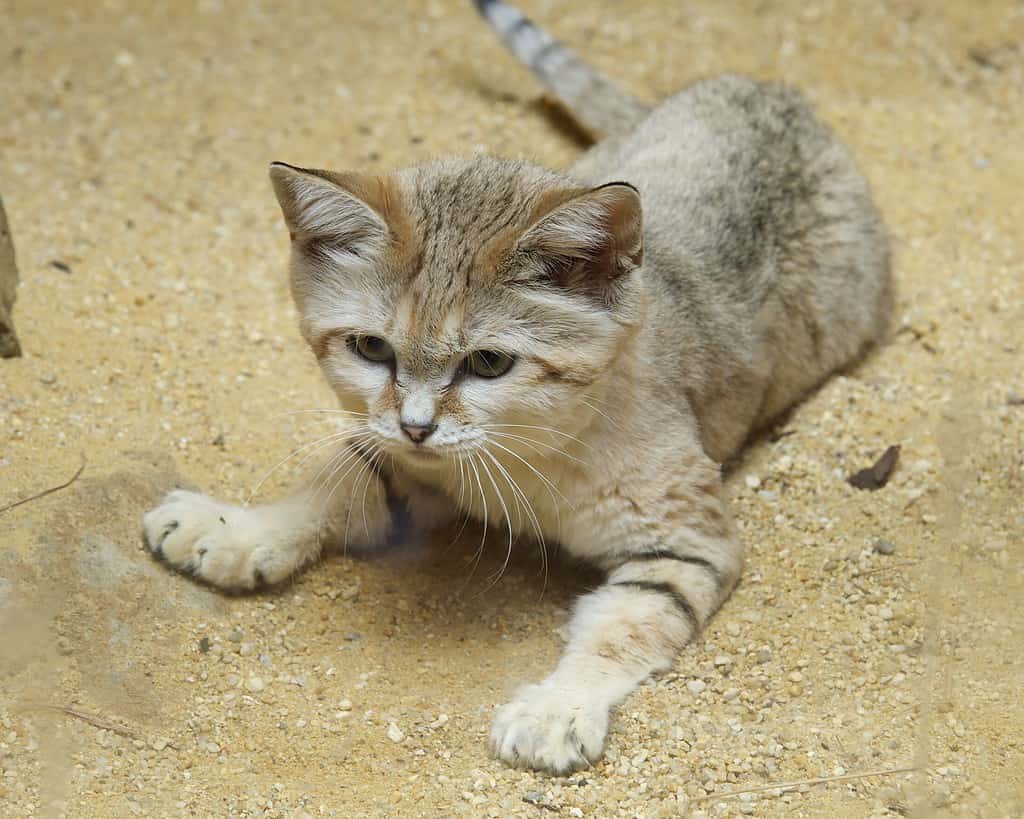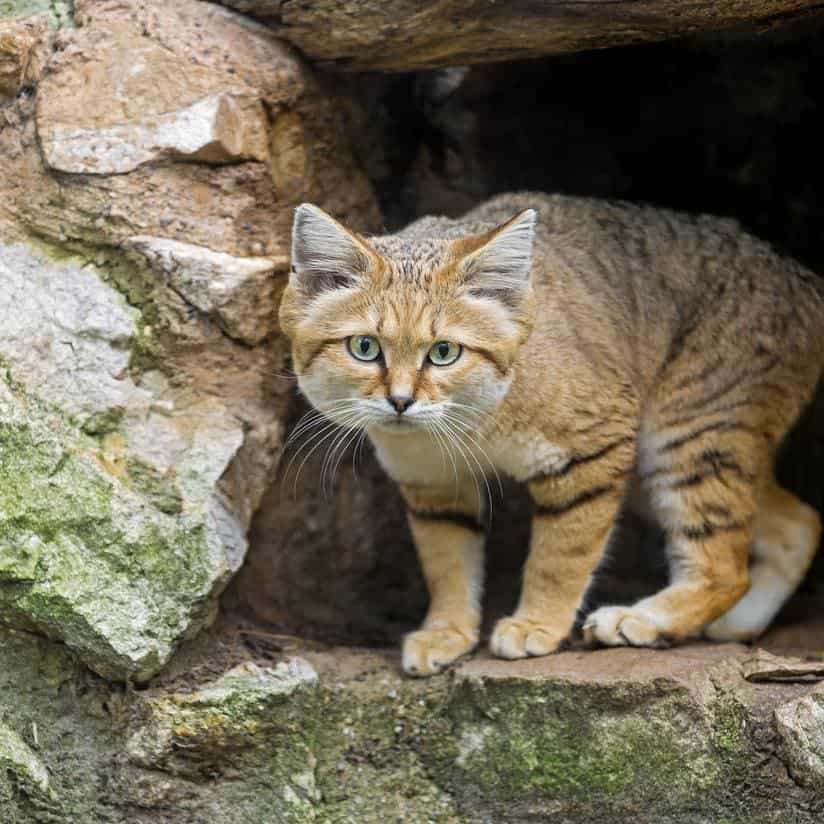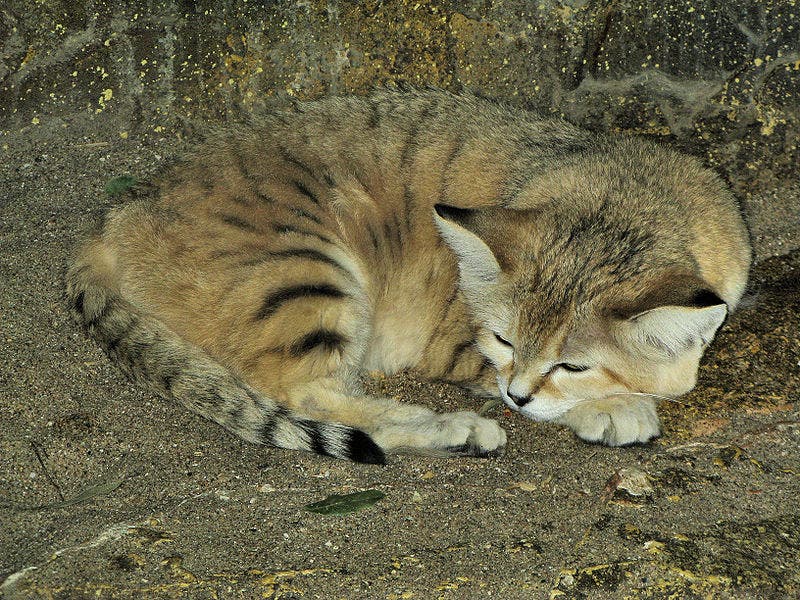The sand cat may not look like a highly skilled killer, but that’s exactly what it is. It’s the only true cat adapted to the desert. Despite its adorable looks, it’s a fierce and adaptable hunter. No doubt, the sand cat is the unlikely king of the desert.

The adorable sand cat
The sand cat (Felis margarita harrisoni) has a wide but not contiguous distribution through the deserts of northern Africa and southwest and central Asia. These gorgeous creatures are highly elusive and people rarely get to see them in the wild. They’re also solitary creatures: they only get together when they mate.
They don’t really like the dunes. There’s not much prey available in the open dunes, and prey is among the top things a sand cat enjoys. However, the loss of sand dunes due to man-made activity is a big threat to sand cats as it’s destroying their habitats.
If you’d like to meet this elusive creature, your best bet is to go out in the desert when the temperature is between 11 and 28 °C — that’s an ideal range for the sand cat. These felines also prefer a very dry, arid habitat with little vegetation, as well as flat or rolling terrains. If it gets too hot outside, the sand cat will retreat to burrows.
Sand cats are also extremely resilient, with thickly furred feet. This enables them to thrive in both very high and very low temperatures. The long hairs growing between its toes create a cushion of fur over the foot pads which insulates it from the very hot sand. They sometimes dig burrows in which they hide away from the extreme weather.
They don’t grow bigger than a house cat and their tails, which can be as long as half of the head-body length, features two or three rings and a black tip.

They can easily live in areas far away from water, and even though they drink water when they can, they get enough hydration just from their prey. This prey is usually small rodents, but occasionally the sand cat will hunt hares, birds, spiders, insects, and reptiles. And out here in the scorching desert, the sand cat is bound to face venomous snakes — luckily for the cat, it’s an expert snake-killer.
It might look like a house cat, but make no mistake — this feline is a versed hunter. Despite its cartoonishly cute eyes, when the sand cat spots prey like a small mouse, it will instantly flatten itself, slink along the sand, and ultimately capture its prey in the blink of an eye.
Sand cats aren’t picky, they’ll eat whatever they can hunt — which is basically anything smaller than itself. In the Sahara, they’ll primarily hunt small rodents and hares. But they also eat lizards, snakes, and even some fish. They’ve also been reported to go into human cats and eat camel milk — classic cat behavior.
If they hunt more than they can eat, they’ll usually bury the remains and come back for it later.

Sand cat conservation
Habitat degradation is the major threat to the sand cat, which is listed as “near threatened” by the IUCN. Vulnerable arid ecosystems are being rapidly degraded by human settlement and activity, especially livestock grazing. They are very hard to breed in captivity and are vulnerable to a number of respiratory diseases.
However, their actual population numbers are not known. Because they’re so elusive
To make matters worse, they’re easy to kill by humans, often for sport, because they freeze when pursued. Some animal behaviorists think this is because these cats think they can’t be seen against the sand.
Luckily for them, the cats are very elusive. They’re also very solitary by nature as they come together only for mating during the April season. The cats make all kinds of noises when they’re in heat. Just like your own kitty, the sand cat mews and purrs, but can also yelp like a chihuahua. Usually, a mom gives birth to two to five kittens.

In January 2010, the Al Ain Zoo announced the first-ever captive birth of two sand cat kittens following in vitro fertilisation and embryo transfer procedure, and in 2012, four sand cat kittens were born at the Ramat Gan Zoo as part of the European Endangered Species Programme.
The captive life, however, doesn’t suit them. As for keeping one as a pet — out of question! As with any wild cat, you should never have a sand cat for a pet, although that doesn’t stop many from capturing them to sell on the black market. Nevertheless, this majestic creature sometimes ends up sold as a pet on the black market.
The sand cat’s place is in the wild. The only time it is acceptable for a sand cat to be in captivity is in conservation programs.

Sand cat studies and other facts
Because this species is so challenging to study in the wild, there’s much we don’t know about it. But that doesn’t mean we don’t know anything about it. Here are some sand cat facts:
- Masters of camouflage: Sand cats’ fur color perfectly matches their desert surroundings, making them nearly invisible to both predators and prey.
- Built-in “sand shoes”: Their broad, furry feet act like snowshoes, spreading their weight across the sand and leaving minimal tracks, while also insulating them from extreme temperatures.
- Ears like radar dishes: Sand cats have large ears, which provide exceptional hearing to detect the faintest sounds of prey hiding beneath the sand.
- Water conservation experts: These desert cats obtain most of the water they need from their prey, allowing them to survive in arid environments without drinking for weeks at a time.
- Burrow dwellers: Sand cats often use abandoned burrows of other animals as shelters, providing protection from the harsh desert climate and a place to rest during the day.
- Sand-digging prowess: They are skilled diggers and can excavate burrows to pursue prey or create their own hideouts.
- Nocturnal wanderers: Sand cats are most active at night when the desert is cooler, sometimes traveling up to 5.6 miles (9 km) in search of food.
- Feline communication: While sand cats are solitary creatures, they use scent marking, facial expressions, and a variety of vocalizations to communicate with one another.
- Climbing abilities: Despite their ground-dwelling lifestyle, sand cats are skilled climbers and have been observed scaling vertical rock faces in search of prey.
- A mysterious existence: Due to their elusive nature and remote habitats, sand cats have been challenging to study in the wild, making them one of the most enigmatic feline species.
Modern research is also uncovering new things about sand cats. For instance, a 2023 study found that sand cats venture far more than previously thought, and their range is greater than expected.
DNA studies also suggested that sand cats evolved as an individual species some 2-4 million years ago, making them a relatively new species. Observations have also found that the sand cat has a pretty unique way of moving around. They walk with their belly close to the ground and take occasional leaps. When they start running, however, they produce impressive bursts of 30-40 km (19-25 miles) per hour. That’s comparable to an Olympic runner’s sprint.
There’s still much we’ve yet to learn about this enigmatic and captivating species. It’s hardly surprising that the sand cat continues to captivate the hearts of wildlife enthusiasts and researchers alike. These small, desert-dwelling felines have adapted remarkably well to their harsh surroundings, making the most of the limited resources available to them in the arid environment.
Despite their elusive nature and the challenges that come with studying them in the wild, ongoing research efforts by dedicated scientists and conservationists are essential to ensure the continued survival and well-being of this fascinating species. As we better understand the unique behaviors and ecological needs of sand cats, we can work collaboratively to develop and implement effective conservation strategies.
Was this helpful?




